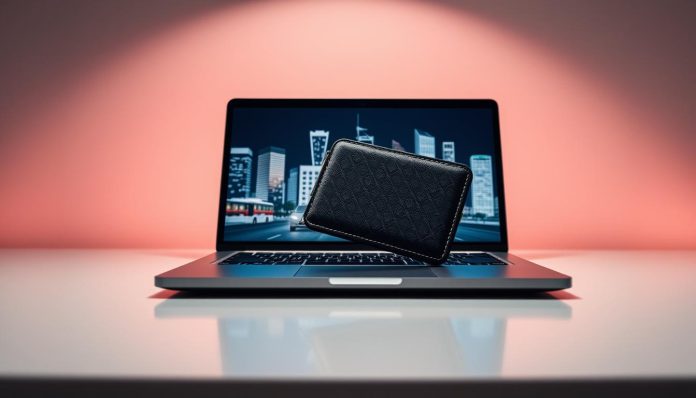We use phones and browsers to move money every day—great for convenience, risky without guardrails.
Online banking, PayPal, Venmo, Apple Pay and crypto are now everyday tools and prime targets for phishing and fake apps. Consumers face threats that aim to grab payment information or trick people into handing over credentials.
The mobile wallet market is growing fast, which makes this an arms race between fraudsters and defenders. Strong passwords, two‑factor login, timely updates and device hygiene are simple, high‑impact steps anyone can take.
But don’t ignore your home network—the main gateway where apps and accounts meet the internet. We believe in layered security: start at the network level, then harden each wallet and account.
That’s where HPN Defender fits. Our solution inspects traffic, blocks phishing domains, and protects every family transaction as it leaves your house.
The new normal of paying by phone, app, and browser in the United States
For most U.S. families, the smartphone has become the default checkout tool—both in stores and on websites. Tap-to-pay, one‑tap browser buttons, and saved cards make purchases faster. That speed drives more volume across the market and shifts how users expect to pay.
Digital wallets have surged: analysts expect them to handle over 50% of global ecommerce value by 2025. In 2024, 48% of U.S. consumers used a digital wallet in the prior 90 days. Most new terminals support NFC for contactless use; merchants welcome shorter lines and fewer abandoned carts.
More use brings more targeted scams. Attackers craft phishing lures that mimic Apple Pay and Google Pay, or they push fake apps at public locations like cafés and airports. Our baseline advice is simple: enable 2FA, keep wallet apps up to date, avoid untrusted Wi‑Fi for financial activity, and teach kids basic spend alerts.
We treat those steps as table stakes. They limit risk while other safeguards—tokenization, device biometrics—work behind the scenes to make this fast way to pay safer by design.
Know the top threats targeting your money today
Fraudsters aim low: trick a user, not crack a bank’s encryption. Phishing emails and texts remain the number one entry point—fake login pages harvest credentials and 2FA codes to drain card balances or move cash fast.
Fake payment apps and look‑alike listings can capture keystrokes or reroute transactions from a legitimate app. Sideloaded APKs are common on third‑party stores; only install from official vendors.
Public Wi‑Fi risks include rogue hotspots and man‑in‑the‑middle attacks that intercept sensitive information. Peer and P2P scams use social engineering—“send $1 to verify”—and once money moves recovery is difficult.
Other attacks: SIM swap or voicemail reset to steal SMS codes, QR code swaps at registers that point to phishing portals, and compromised browser extensions that modify checkout fields.
Defend like this: verify senders, type bank URLs manually, enable app‑based authenticators, keep apps updated, and never approve a login you didn’t start. That’s where HPN makes the difference.
Essential protections to secure digital payments and wallets
A few simple settings on each app and device can stop most thieves before they try.
We recommend a layered approach: start with identity controls, then lock down each app and device. Turn on two‑factor authentication everywhere—prefer an authenticator app or hardware key over SMS for stronger security.

Use a password manager to create unique, long passphrases; never reuse passwords across banking or shopping sites. Update apps and devices weekly—patches close bugs attackers exploit.
Make these habits routine for all household users: enable biometrics and short lock timeouts, limit browser extensions and unknown apps, and remove old cards or addresses so less information is exposed.
Set alerts and spending controls so you see odd activity fast. Back up recovery codes and secure the email account tied to your financial apps. Teach family members one rule: if a prompt or push approval wasn’t started by you, deny it—every time.
That’s where HPN makes the difference. Our solution adds network‑level protection so app hygiene and home defenses work together as reliable layers of security.
Popular digital wallets and how they protect you
Leading apps and services each take a different approach to protecting your card data at checkout. We review the main options so families can pick what fits their devices and habits.
Apple Pay uses NFC plus a Secure Element to store tokens so merchants never see your real cards. It pairs with device biometrics for quick, private purchases.
Google Pay (now Wallet) issues encrypted payment codes, supports 2‑step verification, and offers remote erase for lost phones. Samsung Wallet adds Knox isolation to protect credentials on Samsung devices.
PayPal leads ecommerce acceptance. Venmo and Cash App let users send receive money fast; lock privacy settings and alerts. Zelle moves funds bank‑to‑bank—treat it like cash once you approve a transfer.
Dwolla targets ACH for companies with low transaction fees. Crypto options use hardware keys and offline seed phrases. Walmart Pay uses QR codes for smartphones without NFC.
Bottom line: features differ by company, but hygiene is universal—use 2FA, keep apps updated, and watch for phishing. That’s where HPN makes the difference.
How modern payment tech keeps transactions safer
We often tap or scan without thinking, but several simple technologies work together to protect each transaction.
NFC is a short‑range radio built for contactless checkout. Your phone sends a one‑time token to the reader—fast, private, and designed to work only at close range.
MST mimics a mag‑stripe for older terminals. It’s a fallback method that lets newer phones talk to legacy hardware when NFC isn’t present.
QR codes start a payment by sending transaction details to the app. They are easy to use—just verify the destination before you scan.
Tokenization swaps your real card number for a single‑use value. If a breach happens, the token is useless to thieves.
Biometrics on your device add another gate—no face or finger, no charge—raising the bar for in‑person and online purchases.
Apple Pay and Google Pay pair tokenization with device authentication, which is why major providers call these features an effective way to reduce fraud.
Tech is strong, but the channel matters: encryption protects the payload, yet we still advise avoiding untrusted networks and using network‑level protections at home. That’s where HPN makes the difference.
Why securing your home network matters as much as your apps
Your home router is the unseen gatekeeper for every bank session you start. If the gateway is weak, apps and wallets can’t protect what travels through it.

Every banking and wallet session rides your Wi‑Fi; exposed routers let attackers see or redirect information before an app notices. Old firmware, default passwords, and no DNS filtering are common entry points.
Use WPA3 or WPA2 with a strong passphrase; separate IoT from phones and laptops on a guest or VLAN. Turn off WPS and UPnP unless needed—those features create surprise openings.
DNS filtering blocks phishing domains before pages load; enforcing HTTPS prevents silent redirections that steal credentials or money. Monitor your device inventory—unknown devices are red flags for piggybacking or compromise.
App-level protections are necessary but not sufficient. Network-first layers catch threats that slip past single apps. We build our recommendations so users get full-family coverage with centralized controls.
That’s where HPN makes the difference. Our solution stops malicious traffic and phishing for every device in the house so users can trust both apps and the network edge.
Build layered defenses that protect every payment method
A family-ready security plan stitches identity, devices, and the home network into one strong guardrail for every checkout and transfer.
Identity layer: use unique emails for finance, long passphrases, and phishing-resistant 2FA for each bank and wallet.
Device layer: enable biometrics; set auto-lock; turn on full-disk encryption and OS auto-updates on all devices.
Wallet layer: remove old cards, enable per-transaction alerts, set spend caps, and review monthly statements so odd charges are caught fast.
Card safety: prefer virtual card numbers for online purchases; lock a card or debit account instantly when not in use.
Browser & network: limit extensions; use an HTTPS-only mode and a checkout profile. Use WPA3, guest VLAN for IoT, DNS filtering, and keep router firmware current to stop threats before they reach endpoints.
Backup and drills: store recovery codes offline, test recovery on a spare device, and teach the household to “pause before you pay” for first-time transfers.
That’s where HPN makes the difference.
How HPN Defender secures the financial life of your household
We place protection at the network line — before threats reach any app or browser. Our hardware-based solution inspects outbound requests and blocks known phishing and malware domains at the edge.
Encrypted DNS with policy controls reduces data leakage and stops silent redirects that try to steal bank information. Device profiling identifies new or odd behavior and alerts users in plain English.
Family policies let parents tailor rules: stricter filters for kids, whitelists for finance apps on parent devices, and options that match your home’s range and layout.
Every app benefits — PayPal, Venmo, Apple Pay, browser checkouts, and bank sessions all ride through the same protective layer. That gives session integrity: fewer chances for injection, spoofing, or credential theft.
We don’t change your low transaction fees or payment rails. Instead, we reduce the attack surface so your money and account information stay safer without intruding on privacy.
That’s where HPN makes the difference — choose the option that fits your home and get whole-house coverage that scales with your devices.
Checklist: harden your wallets, bank apps, and network today
Before your next purchase, run through this quick checklist to close common gaps in home defenses.
Two‑factor first: turn on 2FA for every bank and wallet app; prefer authenticator apps or hardware keys over SMS.
Keep software current: install OS, wallet, and router updates. Schedule auto‑updates where possible so patches arrive fast.
Set alerts and limits: enable transaction alerts for cards and debit card use. Configure spend caps in P2P apps you use to send receive money.
Prune cards: remove expired cards, enable virtual numbers for online purchases, and lock any card when not in use.
Harden devices: enable biometrics, shorten auto‑lock on your phone and smartphone, and turn on full‑disk encryption for mobile devices.
Router quick wins: change the admin password, disable WPS, enable WPA3, create a guest network, and use DNS filtering to block phishing at the edge.
Backup plans: store recovery codes offline, test remote erase and restore so a lost phone or mobile device can be wiped within minutes.
Travel tip: avoid public locations’ Wi‑Fi for finance — use your cellular hotspot for sensitive sessions.
Finally: try an HPN Defender trial or schedule installation—start at home to close the network gap that app settings alone can’t fix.
Protect where you connect most—start at home with HPN Defender
Before a tap, transfer, or browser checkout can be intercepted, it meets your home gateway.
Tokenization and biometrics in Apple Pay, Google Pay, and Samsung Wallet already block many threats. We add a network layer that stops phishing domains and malicious traffic before they reach phones or laptops.
HPN Defender protects popular digital wallets without per-app setup. Families get safer banking, fewer “was this you?” alerts, cleaner debit and card sessions, and more confidence when users move money.
Order your HPN Defender install today. Set policies, assign profiles, and let automated updates keep threats off your home network—then relax, thanks to protection that works quietly in the background.

